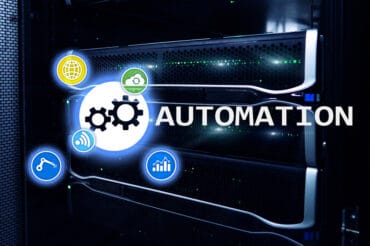
Digital transformation is just a never-ending lesson about change. Those who adapt to it are more successful than those who don’t. However, it is an enterprise-wide activity where people should come first.
When discussing a company’s digital transformation journey, the focus is usually on technology. After all, it is technologies such as artificial intelligence and automation that provide the efficiency and speed that takes a company a long way.
But digital transformation is not only about technology. It redirects the mindset of how your business creates value for customers and empowers your employees along the way.
Many employees, by nature, are not resistant to change – they’re skeptical. In the case of digital transformation technologies, it’s natural for them to wonder,
- How it’ll impact them and their team?
- How their job role will change due to the transformation?
- If they have the right skills to transition to the new reality and how will the company support them?
As a decision maker, it’s your job to communicate what digital transformation is for your organization and how you must consider employee experience just as much as customer experience.
See also: ROI of Digital Transformation is Still Elusive
How does employee experience impact digital transformation?
First and foremost, your employees will be driving your digital transformation initiatives. So start considering your employees as they’ll be working with the new technology and processes daily. The benefits of a good digital employee experience include:
1. Enhanced productivity
Providing the right tools for employees will certainly influence their productivity. Proper technology is required to simplify tasks at the hands of your employees. Without that, they have to devote more time and energy to bypass inefficient systems or develop their own ways to complete daily tasks.
Providing simple tech solutions like a centralized digital workplace will make information easy to access. It’ll prevent context switching and facilitate easy use of applications/ software. As a result, employees can do more in less time, which will lead to increased productivity.
2. Aligned workforce
By focusing on employees, they can be empowered and converted into a fully aligned workforce. The shift from traditional business structures and conventional hierarchies will improve internal communication, uplift employee morale, and knowledge sharing. Therefore, employees are more likely to contribute positively.
3. Better customer experience
When the digital interactions of your employees are simple, both the employee and customer experience will improve. Streamlining customer interactions by introducing elements such as automation will help employees focus on customers who need more in-depth support. This enables your employees to overcome customer dissatisfaction. In addition to this, your customers will also get a promising view of your company through which you can forge partnerships to open new markets.
4. Revenue growth
Happy employees are productive, and productivity will eventually assist your business to generate more revenue. In fact, Fortune analyzed and found that employees who rejoice working in an organization experienced strong financial performance. So enhancing your employee experience will have a promising impact on your bottom line.
What are the challenges in prioritizing employee experience?
Enforcing an optimal employee experience is not a smooth process. Knowing the obstacles upfront will help you be prepared.
The challenges in aligning digital transformation with your organization’s employee experience include:
1. Cost
For constructing a good employee experience, a significant amount of financial investment is required. To get the required funding, you have to explain how the upfront investment will balance long-term and short-term financial payoffs.
2. Gaining stakeholder buy-in
You need to overcome the resistance to the dangerous phrase, “That’s the way things have always been done.” Convincing stakeholders that digital transformation is worth the investment is just one hindrance. You may also need to convince employees initially that the learning curve that comes with using new technology will make their work more straightforward.
3. Tech stack
Outdated technology is a leading contributor to low productivity and performance. To introduce new tech into a business, you need to track the employee resistance that can hamper the rollout of such initiatives. This pushback must be considered with any digital transformation strategy.
4. Change management
Digital implementations will always be accompanied by multiple shifts and changes. So your employees need to be properly trained. Even your workflows and business operations need to be changed. This type of organizational transformation will need thorough planning and adaptability.
Best practices to boost employee experience for digital transformation
Consider these best practices to successfully move the digital transformation initiatives at your organization:
1. Put your employees ahead of technology
The technology and tools you select must serve your employees and address their pain points. Collecting feedback from employees will help you identify what will liberate them to work efficiently. Technology must make your employees’ life easy. Any effort that doesn’t focus on a positive employee experience will fail to fulfill its objectives.
2. Describe what you want to accomplish
When you’re venturing on a digital transformation journey, picture your employees as your customers. Clearly communicating your digital transformation vision for the company is just as important as creating a strategy. You won’t make it far if your employees are not on board in your digital transformation journey.
Whether you have 10 or 1000 employees, a closed-office environment will lead to fear, rumors, and sometimes even anger. As a result, it’s completely natural for employees to push back and question. So, they need to understand the new company vision and what needs to be done to make it happen.
Consider explaining the following to your employees,
- What does digital transformation mean to your company?
- Why is your organization going through this change?
- What are the new technologies that will be introduced in the day-to-day activities?
- What is the duration of the transformation?
- How will you prepare employees for the transformation?
3. Gather a cross-functional squad
A cross-functional group of individuals who contribute diverse viewpoints should take the lead in implementing the employee experience strategy; direct your cross-functional team to think in terms of technology, business processes, and organizational structure so they can highlight the issues in the table.
For example, the squad can have HR as the leader, internal communications to encourage the process, IT to put the tools into practice, and key employees to test the tools for the experience.
This will allow leaders and team managers to better understand things and discuss them with their team members. Employees will also feel more comfortable getting this information from their immediate managers.
All of these initiatives will prepare employees for the digital transformation journey, provide transparency, and remove fear, uncertainty, and doubts.
4. Research and select the technology
The world is changing at a fast pace, and new technologies are being introduced at lightning speed. So, as a part of your digital transformation plans, you need to spend some time understanding how various technologies will impact your organization.
Many companies acquire dozens of technologies to digitally transform their business processes. This will create friction and information silos. So you need to invest in tools and systems that will streamline, not confuse, your employees’ digital experience.
You must be able to tailor every aspect of your employee experience through the technology you choose – tools and information delivered to every employee, channels through which they’re delivered, and how employees are notified. This level of granular targeting and orchestration will personalize the experience of each employee.
5. Do not change everything at once
Rushing digital transformation initiatives will cause chaos and struggle. You need to balance and, at the same time, preserve your employee experience. So, break down the changes into small portions.
Begin with one and then go project by project. This will allow you to observe your employee’s real-time usage of the tools. It’ll give you an idea of the areas in which ‘learning, adapting, and evolving’ are required.
6. Provide training
You have to support your employees through the transition by providing proper technical assistance. Without training, your employees will not experience the new approach and will end up disappointed. You can also motivate employees by providing incentives like prizes, time off, or free meals for the successful completion of the training.
Summing it up
Digital transformation is just a never-ending lesson about change. Those who adapt to it are more successful than those who don’t. However, it is an enterprise-wide activity where people should come first.
The path to a positive workforce experience is an uphill task and requires a lot of changes, but the potential business benefits are well worth the effort.
Remember, it all begins with educated, motivated, and engaged employees. Their fulfillment leads to happy customers, which in turn leads to happy shareholders and a digitally progressive organization.





























